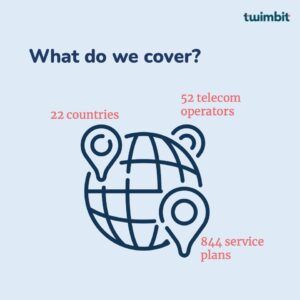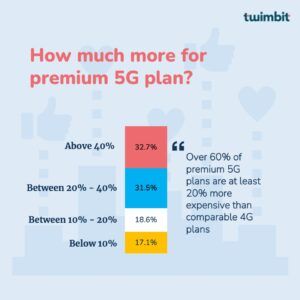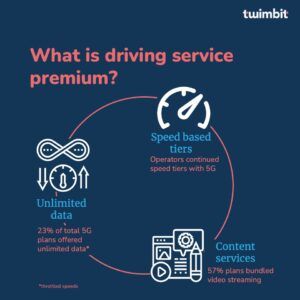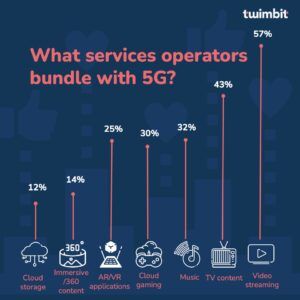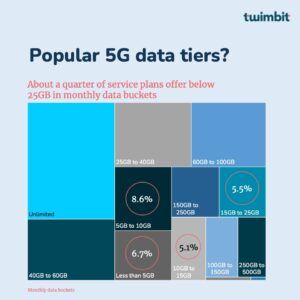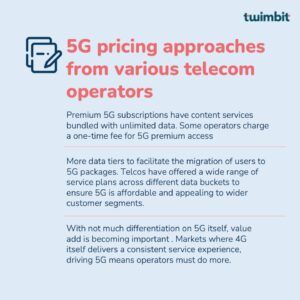Setting the context right – to go premium or not to?
5G has been around for about two years now in many markets. Has the technology disrupted service providers in any way yet? No – as many industry experts have already claimed, 5G is an evolution; not a revolution. We note a similar approach from service providers towards the monetisation of 5G services. They are on a low-risk and low-rewards track. We have known service providers to always stick to proven business models; COVID-19 took away the remaining risk appetite.
Having said that, we believe operators have not committed to specific strategies around 5G pricing. While Telcos wait for other support systems and IT infrastructure to assist their transition to different pricing models, they may continue experimenting with their 5G propositions.
The 5G propositions from most service providers is perhaps an extension to their existing 4G capabilities, with limited use cases to demonstrate any innovations in existing business models. A review of 5G service plans resonates with this view, as most operators have adopted 4G pricing models for the new service.
Operators, with few exceptions, are providing 5G services at no premium to equivalent 4G service plans. They are right to do so. Should they price 5G differently? We analysed 5G service packages from operators across major markets to list few questions to trigger this discussion.
Figure 1: Percentage of 5G service plans sold at a premium to equivalent 4G plans, mobile broadband
5G pricing approaches from various telecom operators
1. Premium 5G subscriptions have content services bundled with unlimited data. Some operators charge a one-time fee for 5G premium access
Operators are taking a different approach to improve average revenue per user (ARPU) with the introduction of 5G. Some use an add-on fee for 5G access. Most others have relied on bundling premium services to support their premium charges for 5G packages.
Figure 2: Larger data caps and content are driving premium 5G services
1.1 Giving consumers time to experience 5G with a moderate access fee
Most operators are sticking to the basics of lowering 5G access barriers for customers. There are two key issues that operators are trying to address: owning a 5G device and migrating to a 5G service plan.
Customers in developed markets have long-term service contracts lasting 12-36 months, with device subsidies and benefits spread across their service plans. Early termination or switching out of contracts is still expensive in few countries, despite regulations put in place. Telcos are, instead, encouraging early adopters to 5G via enabled add-ons. These add-ons allow the user to experience the 5G network beforehand without switching from LTE plans. As a flexible component, the add-on has a monthly access fee.
- STC Bahrain has put a modest fee for 5G access on existing 4G LTE packages. The 5G access add-on is charged at BD 3 per month (USD7.9), providing access to its 5G network.
Figure 3: Add-on charges for 5G access on existing LTE packages
1.2 Truly unlimited data plans are popular with 5G users. However, these large data buckets alone lack the push to drive ARPU
Large data buckets and truly unlimited mobile data was not common until 5G appeared. About 23% of all 5G service plans globally are labelled unlimited, most with speed throttling. Advanced markets from Western Europe, Asia Pacific, and North America are vigorously pursuing ‘unlimited propositions’ as means to differentiate 5G.
The global average for mobile data per subscriber still hovers much below 30GB per SIM per month, questioning the value proposition of truly unlimited data plans. As per tefficient, Kuwait’s Zain reports the highest mobile data usage at 40GB per subscriber per month. In second and third places are DNA in Finland and Three in Austria, at 34.8GB and 30.5GB, respectively.
On the positive side, unlimited propositions are helping operators quickly grow data usage on mobile broadband.
Figure 4: Unlimited as a share of total 5G data plans
How are operators using unlimited propositions to up-sell high-end 5G plans?
There are two ways operators are achieving up-selling positively on high-end 5G plans.
- Examples from South Korea, Japan, and the US showcase several choices built around the basic unlimited 5G plan.
- KDDI in Japan offers three variants to its unlimited 5G data packages. The most basic proposition focuses on the freedom to consume more data. The company introduced Data Max 5G plan in March 2020, offered at the same monthly price as its 4G LTE plan.
- LG U+ has eight different unlimited data 5G service plans, with differences in each plan’s shared data benefits and the option to include premium services. Some premium offerings include Geforce Now Pro, Genie Music, U+ kids and the movies pack. By providing varying service packs with prices that go in tandem with 5G-rich services and content, the telcos enhance the overall value for their customers. For example, LG U+ provides a full-on 100% discount on VR glasses for customers on its premium package and an additional 30% off for content paid on LG VR apps.
Figure 5: ARPU soars through premium tiers in 5G unlimited plans
2. The other set of examples include Vodafone, which introduced speed-tiered unlimited plans.
- Vodafone UK has taken a unique hybrid approach for 5G plans by mixing up speed tiers with content add-ons. Its 5G unlimited plans differ by capped speed and the bundling of content. Such speed-based tiers, however, are not popular in many markets, and Asia in particular. The lack of interest may be due to the regulatory hurdles encountered by operators, which come in on speed-based plans with net neutrality.
Figure 6: Speed and content-based tiers for 5G plans, Vodafone UK
2. More data tiers to facilitate the migration of users to 5G packages
Some operators have looked at migrating subscribers to 5G services without creating much pricing disruptions. They have offered a wide range of service plans across different data buckets to ensure 5G is affordable and appealing to a wider customer segment.
Lack of specific use cases or a clear value proposition means operators focus solely on migrating subscribers to 5G by lowering their service uptake barriers. In this sense, many operators are promoting 5G-ready plans – access is available on a when-or-where basis.
At the same time, some telcos have identified few customer segments, such as gamers, where 5G delivers value today. 5G pricing and value proposition for these specific customer segments, therefore, take a different route, focusing on charging higher premiums.
Figure 7: Share of 5G data tiers offered by service providers, globally
- The entry-level SIM-only 5G plan for Three UK starts from a 4GB per month data bucket. The operator offers monthly, yearly, and 24-month contract plans. Within each category, 5G is available with the most basic data tiers of 4GB, 8GB, 12GB, 30GB, going up to unlimited.
Figure 8: 5G access on entry-level 4G data plans
3. Operators within the same geographies are monetising 5G differently
There are huge gaps between the least and the most expensive 5G packages, indicating that operators in similar markets take different routes to recoup investments. Operators also do not stick to the standard practice of bundling newer tech with high-end smartphones. COVID-19 has triggered these disruptions to a certain extent. China makes for a good example, where low-priced 5G plans counter the weak demand for high-end phones. To date, almost all China OEMs introduced 5G smartphones at an average of USD 215, with the lowest price found at USD150.
Figure 9: Gap between least and most expensive 5G service plans, globally
3.1 Operators have leveraged 5G to amplify the gap with challenger brands
Operators from the Middle East, particularly, have shown very differentiated approaches towards 5G. There are several reasons, the most promising of which is amplifying existing differentiation capabilities with 5G. For instance, operators with smart-home services have quickly integrated 5G into existing offerings. Zain Kuwait is an example. Its Zain Life portfolio of smart-living services and solutions offered a ready ground to leverage 5G’s enhanced capabilities. Zain provides the most expensive 5G service plans in the country.
4. With not much differentiation on 5G itself, value add is becoming important
The per GB pricing of 5G is lower than average for other technologies in many markets. Better speeds with 5G are driving monthly data consumption, therefore lifting average revenue per user. In markets where 4G delivers a consistent service experience through download speed and availability, driving 5G means operators must do more. We see more service packages with bundled value-added services in these markets.
Figure 10: Popular value add services with 5G packages
- China Mobile offers more value-added service options compared to its peers: The three operators, China Unicom, China Telecom, and China Mobile, have similar 5G service packages. All of them provide an entry-level package for a minimum monthly standard service fee of USD18, whereas the highest packages are available up to USD124. The average price per GB varies between USD0.44 to USD0.45 per GB for 5G from the three operators. China’s largest mobile operator, China Mobile, does not price differently from the other two. It, however, offers more value in service adds, particularly for cloud storage.



